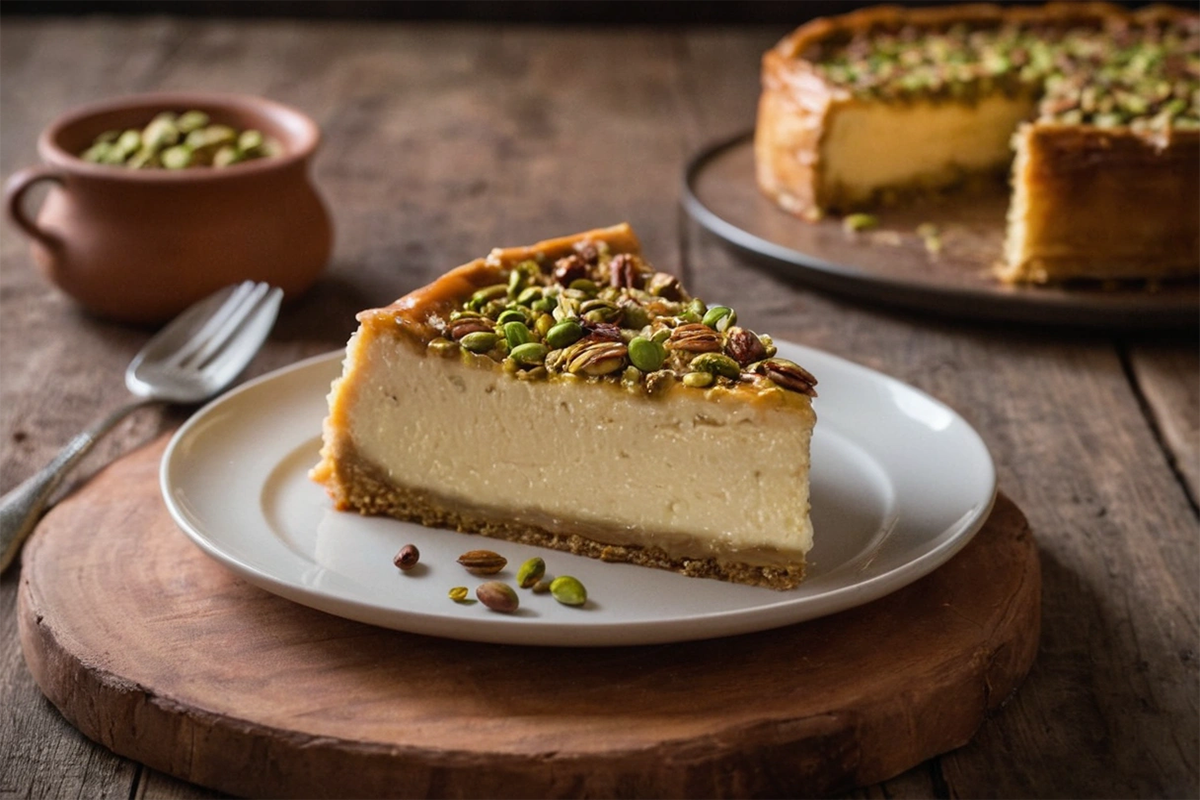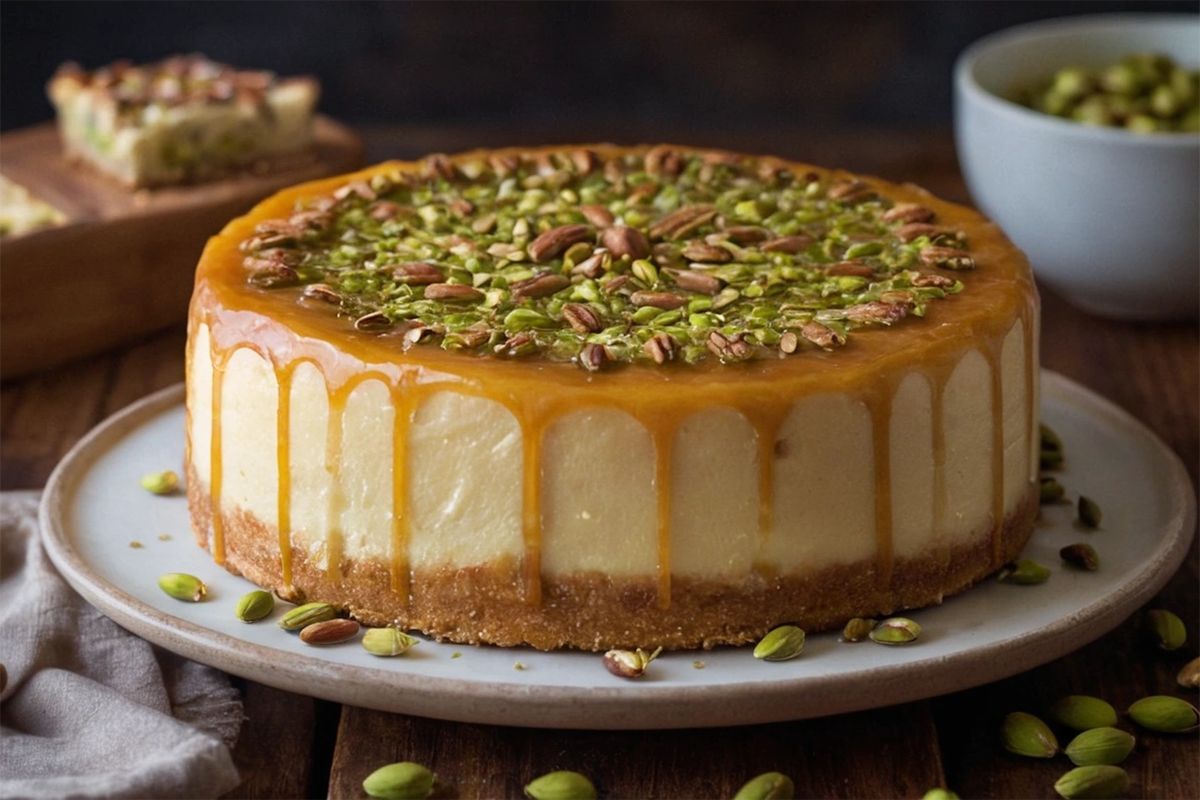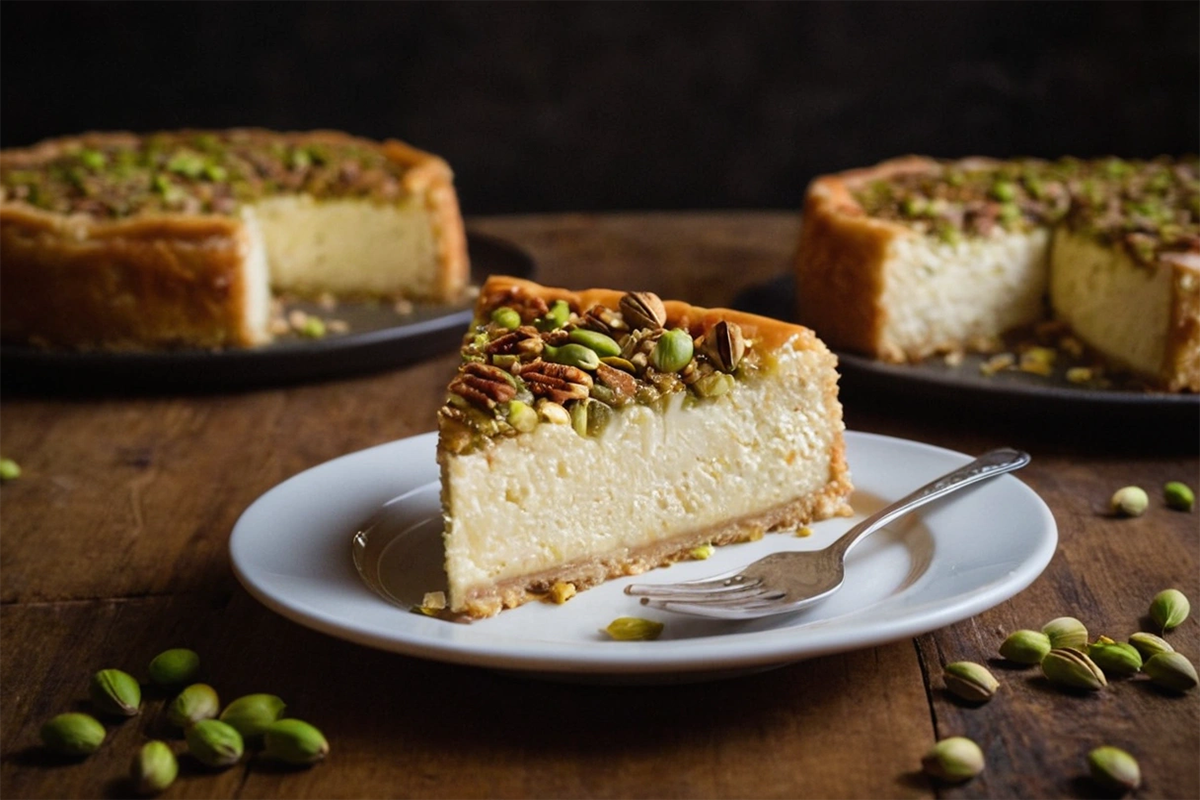Introduction to Honey Pistachio Baklava Cheesecake
When it comes to desserts that truly wow the crowd, Honey Pistachio Baklava Cheesecake stands out as a showstopper. This dessert combines the rich, creamy texture of cheesecake with the crunchy, sweet layers of traditional baklava. The result is a fusion dessert that not only looks stunning but also offers a delightful mix of flavors and textures. Whether you’re hosting a holiday dinner, celebrating a special occasion, or simply indulging in a sweet treat, this cheesecake is bound to impress.
The magic of this dessert lies in its harmonious blend of Mediterranean and Middle Eastern flavors, brought together by the silky richness of cheesecake. If you’re looking to explore more Mediterranean dessert recipes, explore more Mediterranean dessert recipes. And if you want to perfect your technique with phyllo dough, learn how to work with phyllo dough.
Table of Contents
History and Origins of Baklava and Cheesecake
The story of Honey Pistachio Baklava Cheesecake is as rich as the dessert itself. To fully appreciate this fusion, it’s worth exploring the origins of both baklava and cheesecake.
The Origins of Baklava
Baklava, which originated during the Ottoman Empire, is a beloved treat across the Middle East, Mediterranean, and Balkans. Traditionally, bakers create baklava by layering thin sheets of phyllo dough with butter and crushed nuts, typically pistachios or walnuts. After layering, they bake the dessert until crisp and golden, then drench it in a sweet syrup made from honey, rose water, or orange blossom water. This process results in a dessert that is both flaky and moist, perfectly balancing sweetness and texture.
People have long associated baklava with special occasions, often serving it during holidays and celebrations. The labor-intensive process of making phyllo dough from scratch contributes to its status as a dessert reserved for significant moments. However, the availability of pre-made phyllo dough has made baklava more accessible, allowing it to be enjoyed as an everyday treat in many households
Cheesecake Through the Ages
Cheesecake, on the other hand, has its origins in ancient Greece. The earliest recorded cheesecake was served to athletes during the first Olympic Games in 776 BC. Over the centuries, cheesecake evolved, with each culture adding its twist. The modern cheesecake, rich with cream cheese and often baked in a graham cracker crust, is a staple in many American homes. Its versatility allows for endless variations, from fruity toppings to chocolate swirls, making it a dessert that can be adapted to suit any palate.
Fusion Desserts
The concept of fusion desserts, where elements from different culinary traditions are combined, has gained popularity in recent years. Honey Pistachio Baklava Cheesecake is a perfect example of this trend, bringing together the best of both worlds— the crunchy layers and sweet syrup of baklava with the creamy richness of cheesecake. This fusion not only elevates the flavors but also adds an exciting twist to traditional desserts.
Ingredients for Honey Pistachio Baklava Cheesecake
Creating Honey Pistachio Baklava Cheesecake requires a combination of simple yet flavorful ingredients. Here’s a breakdown of what you’ll need:
Phyllo Dough
Phyllo dough, also known as filo, is the foundation of baklava. These paper-thin sheets of unleavened dough create the crispy layers that define the dessert. Handling phyllo dough requires some care, as it dries out quickly and can tear easily. It’s recommended to keep the sheets covered with plastic wrap while working to prevent them from drying out.
Nuts
Pistachios and walnuts are the stars of this dessert, providing a nutty flavor that complements the sweetness of the honey syrup. Pistachios are particularly popular in Middle Eastern desserts for their distinct flavor and vibrant green color. Walnuts add a slightly bitter, earthy note that balances the richness of the cheesecake. You can also substitute other nuts like almonds or hazelnuts if desired.
Honey
Honey is the key ingredient that ties this dessert together. It’s used in both the syrup that soaks into the baklava layers and the cheesecake filling. The honey adds a natural sweetness and floral notes that elevate the overall flavor profile. For an added layer of complexity, consider using raw honey, which has a more robust flavor.
Cream Cheese Filling
The cheesecake component of this dessert is made with a classic cream cheese filling. The cream cheese provides a smooth, rich texture that contrasts beautifully with the crunchy baklava layers. To enhance the flavor, lemon zest and vanilla extract are added, giving the filling a bright and aromatic quality.
Flavor Enhancers
To add depth and complexity to the dessert, spices like cinnamon and cardamom are incorporated into the nut mixture. These warm spices complement the nuts and honey, creating a harmonious blend of flavors. The lemon zest adds a subtle citrus note that cuts through the richness of the cheesecake, while the vanilla extract enhances the overall sweetness.

Step-by-Step Instructions for Making Honey Pistachio Baklava Cheesecake
Making Honey Pistachio Baklava Cheesecake might seem daunting, but with a little patience and attention to detail, you can create this stunning dessert. Here’s how:
Step 1: Preparing the Phyllo Crust
Start by preheating your oven to 350°F (175°C). Lightly grease a 9-inch springform pan with melted butter. Lay a sheet of phyllo dough across the bottom of the pan, allowing the edges to hang over the sides. Brush the phyllo with more melted butter, then add another sheet of phyllo, laying it in the opposite direction to create a crisscross pattern. Continue layering the phyllo, brushing each layer with butter, until you have about 10 sheets.
Sprinkle a handful of the chopped pistachios and walnuts over the phyllo. Repeat the process of layering phyllo and nuts until you have used up half of the phyllo dough and nut mixture. This layering process creates the characteristic flakiness of baklava.
Step 2: Preparing the Honey Lemon Syrup
While the phyllo crust bakes, prepare the honey lemon syrup. In a small saucepan, combine ¼ cup of honey, ¼ cup of water, and the juice and zest of a small lemon. Bring the mixture to a boil over medium heat, stirring to dissolve the honey. Once boiling, reduce the heat and let the syrup simmer for about 10 minutes, or until slightly thickened. Remove from heat and stir in 1 teaspoon of vanilla extract.
This syrup will be poured over the baklava layers, soaking into the phyllo and nuts, infusing them with sweet, citrusy goodness.
Step 3: Assembling the Baklava Layers
Remove the phyllo crust from the oven and let it cool slightly. Pour half of the honey lemon syrup over the baklava crust, allowing it to soak into the layers. Be careful not to oversaturate the crust, as this can make it soggy.
Next, pour the cheesecake filling over the baklava crust, spreading it evenly with a spatula. The filling should be thick and creamy, filling the pan to the top of the phyllo layers.
Step 4: Preparing the Cheesecake Filling
In a large mixing bowl, beat 4 packages of room-temperature cream cheese with 1 cup of honey until smooth. Add 1½ teaspoons of lemon zest, ½ teaspoon of kosher salt, and 1½ teaspoons of vanilla extract, and mix until well combined. Incorporate 4 large eggs one at a time, ensuring each egg is fully mixed in before adding the next. Finally, add ¼ cup of cornstarch and mix on low speed until the filling becomes smooth and creamy
Step 5: Baking the Cheesecake
Pour the cheesecake filling over the prepared baklava crust, spreading it evenly with a spatula. Tap the pan on the countertop to release any air bubbles. Place the springform pan in a larger roasting pan and pour hot water into the roasting pan to create a water bath. This step helps prevent the cheesecake from cracking during baking.
Bake the cheesecake in the preheated oven for 1 hour, or until the center is set but still slightly jiggly. Turn off the oven and let the cheesecake cool in the oven with the door ajar for 1 hour. This gradual cooling process helps prevent cracks from forming on the surface of the cheesecake.
Step 6: Adding the Nut Topping
While the cheesecake is cooling, prepare the nut topping. In a small bowl, combine the remaining chopped pistachios and walnuts with the reserved honey lemon syrup. Stir until the nuts are evenly coated with the syrup.
After the cheesecake has cooled in the oven, remove it and sprinkle the honey-glazed nuts evenly over the top. Press the nuts gently into the surface of the cheesecake to help them adhere. Let the cheesecake cool completely on the countertop before transferring it to the refrigerator to chill for at least 6 hours or overnight.
Variations and Customizations
One of the great things about Honey Pistachio Baklava Cheesecake is its versatility. Here are a few ways you can customize this dessert to suit your tastes:
Substituting Nuts
While pistachios and walnuts are traditional choices, you can experiment with other nuts like almonds, hazelnuts, or pecans. Each type of nut will bring its own unique flavor and texture to the dessert. You can also use a combination of nuts for a more complex flavor profile.
Different Flavor Profiles
To give the cheesecake a different flavor twist, consider adding rose water or orange blossom water to the honey lemon syrup. These floral waters are commonly used in Middle Eastern desserts and add a subtle, aromatic note to the syrup. Almond extract can also be used in place of vanilla for a slightly different flavor.
Mini Baklava Cheesecakes
If you’re looking for a fun way to serve this dessert, try making mini baklava cheesecakes using a muffin tin. Simply follow the same layering process with the phyllo and nuts, then divide the cheesecake filling among the muffin cups. The smaller size makes these perfect for individual servings at parties or gatherings.
Sugar-Free Option
For a lighter version of this dessert, you can reduce the sugar content by using a sugar substitute in place of honey. There are many honey substitutes available that mimic the flavor and sweetness of honey without the added sugar. You can also reduce the amount of honey in the cheesecake filling and syrup to suit your taste.
Serving Suggestions and Presentation Tips
Honey Pistachio Baklava Cheesecake is a dessert that deserves to be presented beautifully. Here are some tips to make your cheesecake look as good as it tastes:
Pairing with Beverages
This rich and flavorful dessert pairs wonderfully with a variety of beverages. For a traditional touch, serve it with Turkish coffee or mint tea. The strong, bitter flavors of the coffee or tea balance the sweetness of the cheesecake. If you prefer something more indulgent, a glass of dessert wine like Moscato or a sweet Riesling complements the honey and nut flavors beautifully.
Garnishing Ideas
To make your cheesecake even more visually appealing, consider adding a few garnishes before serving. A drizzle of honey over the nut topping adds shine and extra sweetness. Fresh pistachios or a dusting of powdered sugar can also be used to enhance the presentation. For a pop of color, garnish with edible flowers or a few pomegranate seeds.
Presentation
When it comes to slicing and serving, a sharp knife is your best tool. Dip the knife in hot water and wipe it dry between each slice to ensure clean, even cuts. Serve the slices on a cake stand or dessert plates, and don’t forget to drizzle each slice with a little extra honey syrup for added flavor.
Storing and Freezing Tips
If you have leftovers or want to prepare this dessert in advance, here’s how to store and freeze it:
Storing
Store the cheesecake in the refrigerator, covered with plastic wrap or in an airtight container, for up to 5 days. The phyllo crust will soften slightly over time, but the flavors will continue to develop, making it even more delicious.
Freezing
To freeze the cheesecake, wrap it tightly in plastic wrap, then in aluminum foil to prevent freezer burn. Freeze for up to 3 months. When you’re ready to enjoy it, thaw the cheesecake in the refrigerator overnight. The texture may be slightly different after freezing, but the flavor will remain just as delightful.
Health Considerations and Nutritional Information
Honey Pistachio Baklava Cheesecake is undeniably rich and indulgent, so it’s important to enjoy it in moderation. Here’s a look at its nutritional content:
Caloric Content
This dessert is high in calories, with each slice containing approximately 500-600 calories, depending on the portion size. The richness of the cream cheese, butter, and nuts contributes to the calorie count, making it a dessert best enjoyed on special occasions.
Sugar Content
The honey syrup and cheesecake filling make this dessert quite sweet. If you’re looking to reduce the sugar content, consider using a sugar substitute or reducing the amount of honey in the recipe. You can also serve smaller portions to keep the sugar intake in check.
Allergen Information
This cheesecake contains common allergens like dairy, nuts, and gluten. For those with dietary restrictions, consider substituting ingredients like dairy-free cream cheese or gluten-free phyllo dough. Always check the labels of your ingredients to ensure they meet your dietary needs.

FAQs About Honey Pistachio Baklava Cheesecake
Can I use different nuts in this recipe?
Yes, you can substitute pistachios and walnuts with other nuts like almonds, hazelnuts, or pecans. Each type of nut will bring a unique flavor to the cheesecake, allowing you to customize the dessert to your taste.
How far in advance can I make this cheesecake?
You can make Honey Pistachio Baklava Cheesecake up to 2 days in advance. Store it in the refrigerator, tightly covered, to keep it fresh. The flavors will continue to meld, making it even more delicious when served.
What can I use if I don’t have phyllo dough?
If you don’t have phyllo dough, you can use puff pastry as a substitute. Puff pastry will give you a slightly different texture, but it will still be flaky and delicious. Another alternative is to use a graham cracker crust for a simpler version of this dessert.
Can I freeze this cheesecake?
Yes, you can freeze Honey Pistachio Baklava Cheesecake for up to 3 months. Wrap the cheesecake tightly in plastic wrap and aluminum foil to prevent freezer burn. Thaw it in the refrigerator overnight before serving.
How long does this cheesecake last in the refrigerator?
Stored in the refrigerator, this cheesecake will last for up to 5 days. Make sure to keep it tightly covered to prevent it from drying out or absorbing any odors from other foods in the fridge.
Conclusion
Honey Pistachio Baklava Cheesecake is a dessert that brings together the best of both worlds— the crunchy, sweet layers of baklava and the creamy richness of cheesecake. Whether you’re making it for a special occasion or just because, this dessert is sure to impress. The combination of flavors and textures creates a truly unforgettable dessert experience.
With its versatility, you can easily customize this recipe to suit your tastes, whether that means experimenting with different nuts, adding new flavor profiles, or making mini cheesecakes for individual servings. So why not give it a try? You’ll find that this Honey Pistachio Baklava Cheesecake is not only a feast for the eyes but also a delight for the taste buds.

Honey Pistachio Baklava Cheesecake
Equipment
- 9-inch Springform Pan
- Mixing Bowl
- Saucepan
Ingredients
Phyllo Dough
- 10 sheets Phyllo Dough Keep covered to prevent drying out.
Nuts
- 1 cup Chopped Pistachios
- 1 cup Chopped Walnuts
Honey
- 1/2 cup Honey Used in both the syrup and cheesecake filling.
Cream Cheese Filling
- 4 packages Cream Cheese Room temperature.
- 1 cup Honey For the filling.
- 1.5 teaspoons Lemon Zest
- 1.5 teaspoons Vanilla Extract
- 4 large Eggs
- 1/4 cup Cornstarch
Flavor Enhancers
- 1 teaspoon Cinnamon
- 1 teaspoon Cardamom
Honey Lemon Syrup
- 1/4 cup Honey For the syrup.
- 1/4 cup Water
- 1 small Lemon Juice and zest.
- 1 teaspoon Vanilla Extract For the syrup.
Instructions
- Step 1: Preheat your oven to 350°F (175°C) and grease a 9-inch springform pan. Layer phyllo dough, brushing each layer with melted butter, and sprinkle nuts in between.
- Step 2: In a saucepan, combine honey, water, lemon juice, and zest. Boil and then simmer for 10 minutes to create the syrup.
- Step 3: Pour half of the syrup over the phyllo crust, then add the cheesecake filling on top.
- Step 4: Beat cream cheese with honey, lemon zest, salt, and vanilla. Add eggs one at a time, then mix in cornstarch.
- Step 5: Bake the cheesecake in a water bath for 1 hour. Let it cool in the oven with the door ajar.
- Step 6: Mix remaining nuts with syrup and sprinkle on top of the cooled cheesecake. Chill for at least 6 hours before serving.
